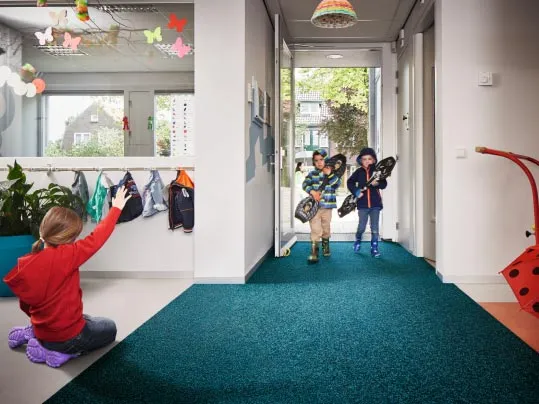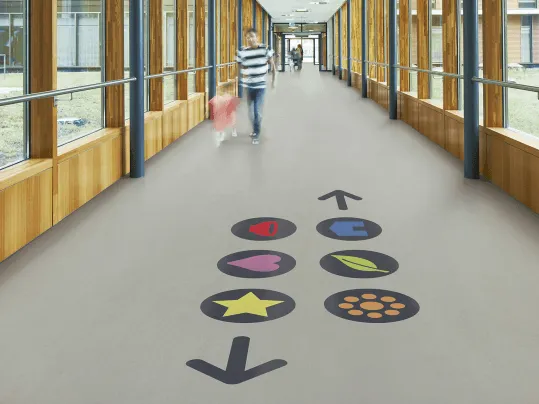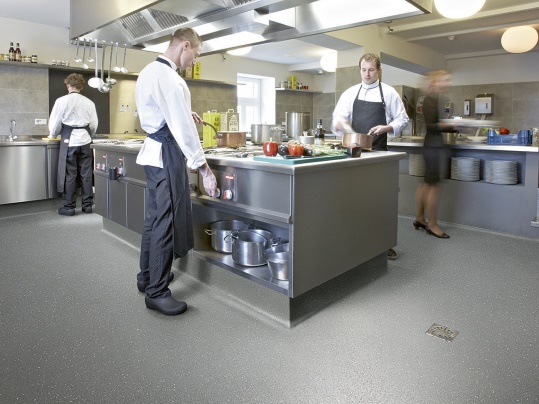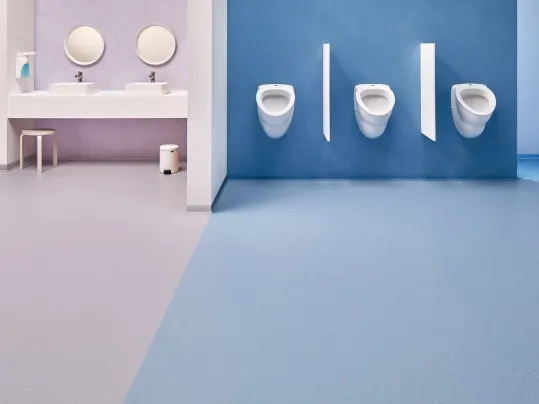A Lesson in Education Flooring Design
Floored It Blog Series
July 2020
.jpg)
As schools across the country prepare to welcome pupils back for the new academic year, Lewis Cooper, Segment Marketing Manager for Education, looks at the latest design advice from the Department for Education and explains how well-chosen floor coverings can help create effective learning environments.
The start of the school year is often a daunting prospect, but for pupils returning after months of homeschooling and uncertainty, the 2020/21 session is even more loaded than usual. Preoccupations about PE kits and pencil cases have been replaced by more serious concerns about social distancing and missed lessons - with teachers, parents and pupils all wondering what the ‘new normal’ will look like in practice.
For education authorities, the drive to provide a secure and supportive environment has never been more important and, as always, good design has a key role to play in this.
The UK education sector encompasses an exceptionally diverse variety of buildings, each with its own set of design challenges. From tiny village primaries, to high-tech purpose-built academies, the requirements vary enormously - and even within an individual school, different classrooms and facilities all require their own flooring solutions.
To provide some clarity on this, HM Government’s Education Skills and Funding Agency recently produced a Generic Design Brief, which contains guidance on the type of floor finishes that should be used in schools. Essentially, the guide states that flooring should be hard wearing, safe and fit for purpose - which includes choosing textures and colours appropriate to the ages and needs of the pupils, particularly those with SEND (Special Educational Needs and Disability).
So, how does this broad stroke guidance translate into real-world flooring solutions? Clearly, hygiene and ease of cleaning are paramount in the current climate, but the complex needs of a school environment mean careful consideration must also be given to factors such as acoustics, durability and slip resistance. Let us consider, then, some of the key application areas that can be found in the average mainstream school.
One of the key stipulations in the Generic Design Guide is that all external entrances should feature suitable barrier matting “to remove dirt and moisture from the soles of shoes and wheeled traffic.” With large numbers of pupils passing through the building every day - most of whom are unlikely to stop to wipe their feet - an effective entrance system is a must.
Whether it’s a rigid first line of defence, like our Nuway range, or a textile clean-off system such as our Coral matting, the entrance flooring is designed to stop up to 95% of dirt and moisture entering the building - which in turn, helps to reduce slips and falls. What’s more, cleaning costs can be cut by up to 65%.

Corridors take a pounding from foot traffic, so floor coverings need to be extra tough to withstand the onslaught. Durability, slip resistance and sound reduction are the key things to consider when choosing solutions for these noisy, busy spaces. An acoustic vinyl sheet such as Sarlon, for example, is a hard-wearing option that can offer impact sound reduction from 15 to 19 dB - perfect for mitigating the din caused by rowdy lesson changeovers.
Where sustainability is a concern, linoleum is an environmentally friendly choice, containing up to 98% natural raw materials and 43% recycled content. Indeed, our Marmoleum 2.5mm sheet is CO2 neutral in its production, from cradle to gate, without the need for carbon offsetting. Linoleum is also an extremely durable material that offers natural bacteriostatic properties, having been independently proven to inhibit the growth and spread of infections such as MRSA, Norovirus, Acinetobacter baumannii and C Difficile.
For school renovation projects, minimising disruption is a priority so it’s worth looking for solutions that can be installed quickly. Modul’up, for example, is a completely adhesive-free sheet vinyl which reduces installation time and can even be fitted over asbestos floors, avoiding the need for expensive and time-consuming removal of existing flooring.
Creating a safe and warm environment is key within general teaching suites, so that pupils feel secure and inspired. However, it’s absolutely critical to get the acoustics right in these areas, as unwanted noise can seriously impair students’ learning ability. Acoustic vinyl sheet is an all-round performer ideal for this application, offering excellent sound performance, along with easy cleaning and a wide range of colours and designs.
Carpet tiles are another popular choice, achieving impact sound reductions of between 22 and 30 dB, to encourage maximum concentration from pupils. Offering an inviting, tactile feel, modular formats, such as Tessera carpet tiles, mean individual tiles can easily be maintained or replaced if they become damaged.
Combining the best of both worlds, flocked floor coverings, such as Flotex, provide the comfort and warmth of carpet with increased resilience, thanks to the hard-wearing flocked construction. Flocked solutions are ideal for classrooms that see heavy foot traffic and movement of chairs, calling for a more durable choice.

Marmoleum Solid Concrete

Flotex Colour

The national curriculum sees pupils studying a broad range of subjects including arts, science and practical skills, such as food preparation and design technology. Safety and high slip-resistance is paramount in these specialist teaching zones, where spillages and debris on the floor can be common.
A safety vinyl sheet, such as Step, that has been specifically designed to minimise the risk of falls and meets all HSE and European safety norms, is the clear choice for these areas. All Step floor covering achieve a Pendulum test value (PTV) of at least ≥ 36. In science laboratories or areas where there is an increased likelihood of contamination, a homogeneous vinyl sheet with an effective top surface finish, such as Sphera, provides a high resistance to chemicals, scratches and stains.
Where music is taught, the Generic Design Brief states that classrooms “should be designed to avoid sound disturbance to and from neighbouring spaces and satisfy the requirements of Building Bulletin 9.” Once again, acoustic vinyl, carpet tiles and flocked floorcoverings are all excellent choices for these areas.
Dining areas are used and abused daily. The Generic Design Brief states that these locations "should contain durable, hygienic and easily cleanable materials". This means choosing products that offer excellent slip resistance, as well as the durability to cope with hundreds of pupils, staff and visitors day in, day out. A hard-working general purpose vinyl sheet, such as Eternal, is the ideal choice, as it offers a practical combination of resilience and safety.
For high-risk areas in terms of slips and falls - like kitchens and bathrooms - a safety sheet vinyl sheet is required. Where this slip risk is due to continuous contamination, look for products with even higher safety ratings, such as Safestep R11 or Safestep R12.
In addition, the Generic Design Brief states that "any sports hall should include changing facilities with showers"; therefore, it’s important to choose flooring that provides appropriate levels of slip resistance, as well as being suitable for both barefoot and footwear areas. Surestep Laguna and Surestep Barefoot, for example, are ideal for wetrooms and changing areas.

With so many different applications within one building, designing flooring installations for schools is a complex matter and while the Government’s design guidelines provide a useful starting point, it can be helpful to seek further advice from a flooring expert to ensure the most appropriate solution is chosen for each area.
If you would like to discuss any of the above solutions in more detail, simply fill in our Online Consultation request form and we'll be in touch.
Request an Online Consultation
View our Schools Design Guide
View our Tertiary Education Design Guide